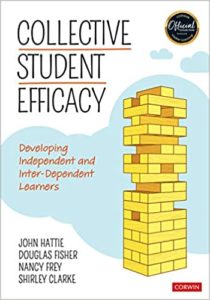The What, Why and How of Collective Efficacy
Collective Student Efficacy: Developing Independent and Inter-Dependent Learners
By John Hattie, Douglas Fisher, Nancy Frey and Shirley Clarke
(Corwin Press, 2021 – Learn more)

My ten year old grandson Hudson was in a graham cracker challenge with three campmates. He told me the first half hour was spent arguing about the design.
Ryan and David wanted to build a house; he and Lawrence wanted something “unordinary” like a spaceship; and there was no way to attach the crackers and candies to build the height needed for either structure.
As they looked around at their competitors, the counselor announced “24 minutes left.” They were in awe of a nearby zip-line sculpture and realized they needed to construct something “small and fast.”
“What do the crackers look like?” Hudson asked.
“Sand!”
So, using their blue poster board as the ocean, they built a beach, replete with Swedish fish, twisted licorice, and Sour Patch candies as “kids” on the shore. And they won a prize for their sandy beach sculpture – coupons for individual ice cream sundaes!

And as a literacy coach, how do I nurture a productive community in Professional Learning Circles and Instructional Leadership Teams when I personally struggle with trusting others to meet quality and deadline expectations?
In search of such truths, and upon the recommendation of an esteemed colleague, I opted to read Collective Student Efficacy: Developing Independent and Inter-dependent Learners, and I am so glad I did. All my questions were answered and I feel sure yours will be too, helping you build your ability to support your learners’ independence and collaboration.
The education thought leaders who wrote this text – John Hattie, Douglas Fisher, Nancy Frey and Shirley Clarke – have collectively harnessed decades of research and experience to inform decisions about building both independent and collective efficacy by refining tasks and processes.
I read the concluding chapter first to understand the goal and core attributes of collective efficacy in order to be more open-minded in accepting the methods.
[Note as you read further: effect size refers to the impact of a factor or strategy on student learning. Anything greater than .45 represents more than one year’s growth in a school year (Hattie).]
What and How?
“Our simplified working definition of Collective Student Efficacy means… students’ beliefs that by working together with other people, they will learn more” (p.10). This efficacy comes about not via a set of activities but through deliberately designed structures and processes.
Educators can shape these beliefs utilizing the common sense advice and guidelines, and the scaffolded structures and resources presented.
If Teacher Collective Efficacy has an effect size of 1.27. why is Collaborative Student Learning only .42? The authors claim that much more could be done to improve student collaboration, and this book shows us how!
How?
The authors explain the learning conditions and application tips to optimize high leverage strategies – such as my two favorite ones that apply across grades and content.
►Reciprocal Teaching in student-centered discourse with comprehension strategies (Hattie .74 effect size). With how-to and illustrative classroom examples, the authors guide teachers in modeling and developing the set of specific “I” and “We” skills so students can contribute confidently, effectively, and reflectively in interdependent work to support individual mastery (Chapters 3, 4 and 7).
Research suggests “starting collective learning by creating learning pairs. Later, once routines have been established so that pairs of students work productively, it is easier to start creating groups of four or snowballing pairs to work with another pair, sharing ideas” (p.118).
I learned the hard way about the need to nurture collaborative skills first. After a three-day seminar on Cooperative Learning, I assigned my seventh graders a consensus problem-solving task that resulted in two boys arguing over who was right. I foolishly stepped between them. The result was I had a bloody lip from Leviticus’ blind rage. He apologized, and I learned that social skills and norms for learning partners have to be modeled and established first.
As a result of reading about “snowballing,” I realize how we may boost collaboration by building “think-pair-square” from groups of 2 to 4 to 8 to prepare for rich whole class discussion.
►Problem-based Learning. The authors inform us that “The effect size of PBL increases from .15 to .50 when … students have sufficient background knowledge” (p.35). By moving students along the continuum from surface to deep acquisition to consolidation of knowledge with research-evident strategies for both individual and group learning (pp. 93-96), classwork and presentation projects can be elevated.
The authors’ sixth grade example of the investigation of the human body shows how students select and research individual topics, then share and extend, in reiterative rounds of Big Paper and discourse – with teacher feedback on their outline before they write their papers and do presentations.
These kinds of supportive structures and processes are well-detailed throughout the book, with actual classroom examples included to ensure success.
Book Features
✻ Rules and tools, roles and responsibilities, and sentence frames for accountable talk and reflection establish conditions for independent and collective work and growth.
✻ “Learning from a Distance” sideboxes show ways to implement learning conditions or techniques in remote environments.
✻ Instructional charts can be displayed on walls and used as mini-anchor charts in students’ notebooks, so students self-direct rather than depend on teachers’ mediation.
✻ Internal page references to “see more” within the book support teachers’ planning and delivery and promote the constructive alignment of learning intentions, tasks, success criteria, and assessments.
Final Reflection
I found the answers! We foster disposition and confidence in our students as actionable agents of learning and future employable citizens by developing both their cognitive and social skills.
We can nurture collaborative learning, on-site and remotely, by intentionally structuring and modeling tasks and roles, and then getting out of the way. We can foster and assess group work through the use of feedback and by moderating grades for individual and group contributions and outcomes.
On a personal level, I will use the metacognitive prompts to develop my own “We” skills and grow more confidence and trust in the experiences and knowledge of others. When I can better find the strengths in others, I’ll be better able to guide their engagement and collective efficacy for sustainable improvement, even beyond my coaching days.
Read another review of Collective Student Efficacy by Sarah Cooper.
Since attaining her Masters from Teachers College, Columbia University, and later National Board Certification, education consultant Helene Alalouf relishes opportunities to share her passion and informed fluency of research-evident principles to ensure a productive learning environment, cognitively and affectively, to support educators and families in realizing their vision. At leisure, she enjoys walking and cooking with family and friends, reading, and knitting.































